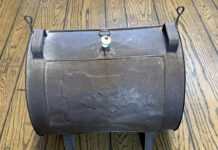By DAVID DUGAN
Over the years we have seen hay go from being taken to the barn loose, to small square bales put in a barn, to small round bales being made to feed right out of the baler.
Then we progressed to large round bales. Many of the large round bales are stored outside until they are fed. Unfortunately the way these bales were often stored resulted in a significant loss of what could have been very usable forage.
Making hay is not cheap and the thought of losing as much as one out of every three bales made some people look for ways to reduce this loss. As a result, we started seeing bales net wrapped.
Some looked at storing the bales on old tires or gravel to allow the water to escape and not stay right under the bales, and some went to storing the bales under a tarp or even storing round bales under roof. All of these reduced the amount of loss.
In addition, producers soon learned to store bales on a slight slope so water would move away from the storage area, and place the bales in rows so air could flow and increase the ability of the hay to dry it would reduce decay.
Cheaper options
Storing bales on a slight slope and creating space between the rows to increase air movement for drying doesn’t have much of a cost, but everything else that I mentioned does. We are trying to reduce hay loss to save money.
Sometimes we have to spend money to save or make money, but sometimes maybe we just get lucky. Maybe we stumble onto something that just might work.
Over the past few years several dollars have been spent to store the hay I feed under roof. Barns have been constructed and the quality of the hay bales going to the feeder is much better.
If the bale is fed on dry or frozen ground, or in another manner where it is not wasted at the feeder, the whole bale is consumed. Basically it is all usable forage just as it was the day it was rolled into a bale.
The cost of a barn might not be in your budget. The cost of using tires or gravel to store the hay on might not fit your system either. In my case, the barn was not big enough to hold all of the hay one year due to not feeding all of the previous year’s hay.
Net wrapping is pretty common now. This past year the cost of net compared to string narrowed, so if the baler had the capability to do both, net might have been done more this year compared to previous years.
The difference, most studies would tell you, is that there is likely to be at least a 10 percent less loss for net wrapped bales compared to string for bales being stored outside. If this is the case, and we use simple numbers like $25 per bale, a 10 percent loss would be one out of 10 bales or $2.50 per bale. The cost difference comparing net to string is nowhere near $2.50 per bale.
Surprise solution
So, with all of that said, back to my case of not having enough barn space for all of the round bales.
These were net wrapped bales that I stored on a slight slope near the feeding area for the winter. They were stored in a long row butted together with breaks every 30 bales or so in case of the freak lightning strike.
As these bales were fed during a time when the ground was either frozen or in most cases wet, I began to make pretty sizable tracks. Because the bales were stacked in a straight row, I had to use the same tracks time after time.
Normally I will work the feeding area down in the spring once the cows have been turned out on grass. I had the area where the hay was stored fenced with a temporary electric fence and did not work that area.
This year I did have a few more bales than I could get into the barn, but because the net wrapped bales kept so well in the area I stored them, and it was much more convenient to feed, I decided to store some in the same area. Plus I already had the fence there.
As I began to store the bales in the same manner as I did the previous year, I noticed the tracks I had made last winter. The bales set up nicely between the two tracks. The bales seem to be elevated with an even better way for the water to get away.
As the water runs off of the bales it drops into the tracks and moves away from the hay.
This was all by accident, but it just might decrease the loss on the bottom of the bales even more this year. Time will tell, since this is a high area in the field and the amount of additional runoff will be minimal.
(David Dugan is an OSU Extension educator in Brown, Adams and Highland counties)












